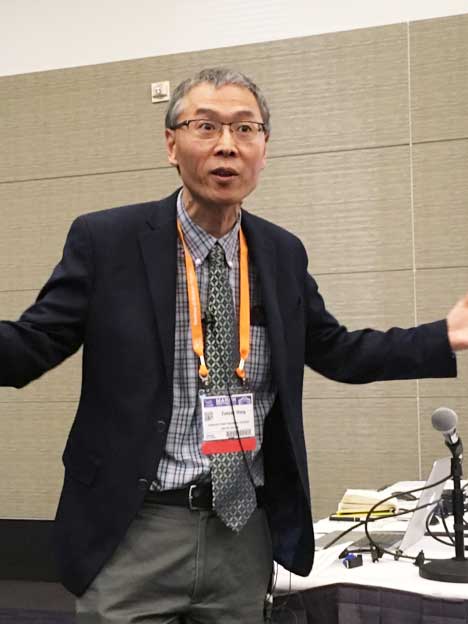History of Contemporary Chinese Physics
By Danian Hu
The invited session entitled “History of Contemporary Chinese Physics,” chaired by Paul Cadden-Zimansky, was successfully completed at the APS annual meeting in Boston on March 5, 2019 despite some unexpected difficulties. This session was originally scheduled to comprise five presenters: Jinyan Liu and Lie Sun from the Chinese Academy of Sciences in Beijing, Zuoyue Wang from California State Polytechnic University, Pomona, Tian Yu Cao from Boston University, and Danian Hu, the organizer of this session, from the City College of New York. Although Liu and Sun were eventually not able to come to Boston due to delayed U.S. visa processing and a family emergency respectively, they each gave an effective presentation via recorded PPT slides and had live online exchanges with the audience in this session.

Zuoyue Wang

Danian Hu
The session began with Hu’s presentation on the endeavor of William Band, a British physicist teaching at the American-funded Yenching University in Beijing, to develop theoretical physics in Republican China during the 1930s. Although Band never fulfilled his aspiration to build China’s first research center of theoretical physics because of the Japanese invasion in 1937, he made a great contribution by introducing advanced theoretical physics into China and mentored many physics students at Yenching, among whom several distinguished Chinese theorists eventually emerged.
Sun discusses five pioneers of applied optics in China who played key roles in the designing and manufacturing of binoculars, optical glass, cinetheodolites, astronomical telescopes, rare earth glass, and laser devices in the mid-twentieth century. These developments demonstrate the critical impact from Europe, especially the USSR, on the establishment of both the optics discipline and optical industry in China, proving significant contemporary knowledge spillovers and technology transfer.
Wang samples four American-educated Chinese physicists Chen Ning Yang, Tsung-Dao Lee, Deng Jiaxian, and Zhu Guangya. Yang and Lee shared the Nobel prize in physics in 1957 while working in the US whereas Deng and Zhu were nuclear physicists who returned to China in 1950 and later became prominent leaders in Chinese science and technology. Wang’s talk explores the entangled trajectories of these four in an attempt to present a nuanced picture of the transnational characters of both Chinese and American science.
Liu examines the genesis of Mao-particle or “straton” in China as a result of Chinese physicists’ effort to classify newly emerged elementary particles and explore the underlying relations between them during the early 1960s. She argues that Mao’s belief in the infinite divisibility of matter directly stimulated the construction of straton, a significant development that was unfortunately interrupted by the Cultural Revolution. Though having little international impact, this Chinese development promoted domestic physics research.
Cao investigates the scientific and political controversies in 2016 over the worthiness of building an extremely expensive great collider in China. He analyzes the intricacies of the asymmetrical manipulative moves at the science-politics interface by the proponents and the dissenters. He concludes his talk with some general remarks on the determinants in agenda-setting for fundamental researches in China and compares them with those in America.
The articles in this issue represent the views of their authors and are not necessarily those of the Forum or APS.
